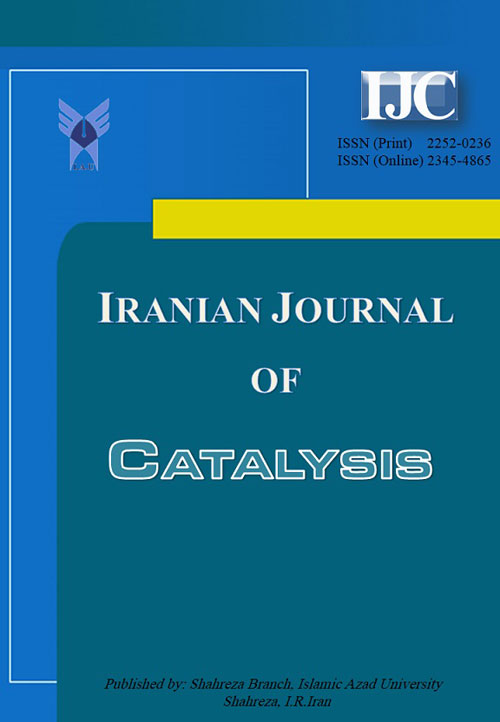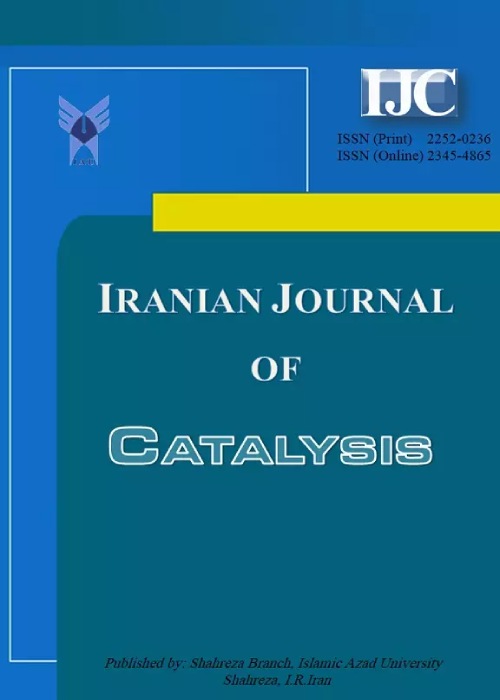فهرست مطالب

Iranian Journal of Catalysis
Volume:7 Issue: 3, Summer 2017
- تاریخ انتشار: 1396/07/26
- تعداد عناوین: 9
-
-
Pages 181-185During this study, we report the green synthesis of magnetic copper ferrite nanoparticles using tragacanth gum as a reducing and stabilizing agent by the sol-gel method. The green synthesized CuFe2O4 MNPs are characterized by powder X-ray diffraction (XRD), Fourier Transform Infrared Spectroscopy (FTIR), vibrating sample magnetometer (VSM) and scanning electron microscopy (SEM). The X-ray powder diffraction (XRD) analysis revealed the formation of Cubic phase ferrite MNPs with average crystallite size of 14 nm. This study has demonstrated that CuFe2O4 nanoparticles can act as an efficient catalyst for selective oxidations of alcohols applying oxone (potassium hydrogen monopersulfate) as oxidant in the presence of acetonitrile as solvent at 40 ºC. Primary and secondary alcohols gave the corresponding products in good yields. Furthermore, the catalyst can be simply recovered and reused several times with almost no loss in activity.Keywords: Copper ferrite, Nanomagnetic catalyst, Tragacanth gel, Oxidation, Alcohols
-
Pages 187-192In situ electropolymerization as a facile synthetic procedure has been used to obtain highly active compositesof ionic liquid functionalized graphene oxide(FGO)and poly ortho aminophenol (POAP). Surface and electrochemical analysis have been used for characterisation of FGO-POAP composite film. Nickel was accumulated by complex formation between Ni (II) in solution and amines sites in the polymer backbone to obtain Ni-FGO-POAP/ graphite electrode. Surface morphology of composite was characterized by scanning electron microscopy. The electrochemical performance of Ni-FGO-POAP composite electrodes was investigated by cyclic voltammetry and Chronoamperometry. Compared with Ni- POAP, a Ni-FGO-POAP electrode shows a higher catalytic performance in the electrocatalytic oxidation of ethanol. Under the CA regimes the reaction followed a Cottrellian behavior. Developing a simple and green route for synthesis of FGO-POAP and long life cycle and stability of nanocomposite are main important factor in presented work.Keywords: POAP, Nanocomposite, Graphene, Electrocatalyst, Ethanol
-
Pages 193-199In the present study, a novel catalyst was well designed by incorporating the tungstophosphoric acid into the magnetic chitosan, as highly stable composite, in which the iron oxides were used the strong super-magnetic core. The prepared composite was characterized by several methods, including FTIR, XRD, SEM, TEM and EDS and its catalytic activity was examined in a facile, green and highly efficient one-pot reaction for the synthesis of N-cyclohexyl-3-aryl-quinoxaline-2-amines with o-phenylenediamine, benzaldehyde and cyclohexyl isocyanide in water, under reflux conditions. This heterogeneous catalytic system was separated easily by an external magnet and was reused at least in four runs without pre-activation and appreciable loss in its activity.Keywords: Magnetic chitosan, Heteropolyacid, Multicomponent reactions, Green synthesis
-
Pages 201-205Tetrazoles have many interesting futures and applications in drug and energy industries. 5-Substituted 1H-tetrazoles were synthesized via [2] cycloaddition reaction of aryl or alkyl nitriles with sodium azide in the presence of Fe3O4@SiO2.SnCl4 as catalyst in DMF under reflux conditions. The catalyst was removed from reaction mixture by an external magnet and was reusable for many times without any appreciable loss of its activity. The Fe3O4@SiO2.SnCl4 promotes synthesis of tetrazole in shorter time than other reported catalysts. The obtained tetrazoles were identified by spectroscopic and physical data such as FT-IR, 1HNMR and melting point. Easy workup and reusability of catalyst are some advantages of this protocol.Keywords: Fe3O4@SiO2.SnCl4, 1H-tetrazoles, Organonitrile compounds, Sodium azide, Magnetic catalyst, Lewis acid catalyst
-
Pages 207-216In this study, silica nanoparticles were used as support to prepare a new heterogeneous catalyst system for application in organic reactions. The reaction of silica nanoparticles with sodium 2-bromoethane-1-sulfonate resulted in the connection of a sulfonic acid group on the surface of silica nanoparticles (NSESA). The synthetic catalyst system was characterized using different microscopic and spectroscopic techniques. After characterization of NSESA, its catalytic activity was evaluated in a multicomponent reaction for one-pot synthesis of xanthene and acridine derivatives. Results of this study show that this catalyst system is effective in this reaction so that a range of xanthenes and acridines were obtained in high isolated yields under optimized conditions. The catalyst system was reusable at least for 7 times without significant decreasing in its catalytic activity.Keywords: Nano-Silica, Heterogeneous Catalyst, Solid acids, Xanthene, Acridine
-
Pages 217-223In this work, Mordenite zeolite was successfully synthesized with Si/Al ratio of 18 in absence of organic template. The hydrothermal method was applied for synthesis under optimum conditions: 24 h synthesis time, 180°C temperature and 2 days aging time. The obtained zeolite was characterized by X-ray powder diffraction (XRD), Brunauer-Emmett-Teller (BET), X-ray fluorescence (XRF), Fourier Transforms infrared Spectroscopy (FT-IR) and Scanning Electron Microscopy (SEM). The prepared sample had total (BET) surface area of 331.63 m2g-1, whereas total pore volume was 0.278 cm3g-1. The catalytic performance of this catalyst was investigated for meta-xylene isomerization reaction in a fixed bed reactor at the 10 bars Pressure, 380°C temperature and 3.35 h-1 Weight hourly space velocity (WHSV) of feed. The results compared with a commercial SAPO-11 catalyst (Si/Al = 20) and showed that the mordenite gave better Para/Ortho ratio (63%) and fewer amount of xylene loss (2.11%) compared to SAPO-11.Keywords: Mordenite zeolite, Catalyst, m-Xylene isomerization, SAPO-11
-
Pages 225-232Co@pyr/APTZCMNPs was synthesized, and some of its characteristic analyses, such as Fourier transform infrared spectroscopy (FTIR), thermogravimetric analysis (TGA), scanning electron microscopy (SEM), energy dispersive X-ray (EDX) and X-ray diffraction (XRD) were investigated. The results indicated that this heterogeneous catalyst was an excellent and reusable system to synthesize of 14H-dibenzo[a.j]xanthene derivatives through a one-pot condensation of β-naphthol and arylaldehydes at 90 °C under solvent-free conditions. Due to the magnetic nature of the catalyst, it could be easily recovered by an external magnetic field and comfortable reused at least five times without loss of its catalytic activity. High yields of the desired product, easy recovery of the catalyst and solvent-free conditions were some of the advantages of our methodology.Keywords: Heterogeneous Catalyst, ?-naphthol, 14H-dibenzo[a.j]xanthenes, Solvent-free conditions
-
Pages 233-241In this study, N1,N1,N2,N2-tetramethylethane-1,2-diamine was reacted with chlorosulfonic acid to afford N1,N1,N2,N2-tetramethyl-N1,N2-bis(sulfo)ethane-1,2-diaminium chloride ([TMBSED][Cl]2) as a new acidic ionic liquid. [TMBSED][Cl]2 was identified by 1H and 13C NMR, mass and FT-IR spectra. Then, its catalytic activity was examined to promote the following multicomponent reactions: (i) the production of 4,4´-(arylmethylene)-bis(3-methyl-1-phenyl-1H-pyrazol-5-ol)s from arylaldehydes and 3-methyl-1-phenyl-1H-pyrazol-5(4H)-one in ethanol, and (ii) the synthesis of 12-aryl-8,9,10,12-tetrahydrobenzo[a]xanthen-11-ones from arylaldehydes, dimedone and 2-naphthol in solvent-free conditions. The ionic liquid was highly efficient and general catalyst for these reactions.Keywords: Acidic ionic liquid, [TMBSED][Cl]2, 4, 4´-(Arylmethylene)-bis(3-methyl-1-phenyl-1H-pyrazol-5-ol), 12-Aryl-8, 9, 10, 12-tetrahydrobenzo[a]xanthen-11-one
-
Pages 243-248Ionic liquid N-ethylpyridinium hydrogen sulfate has been prepared, characterized and used as an efficient recyclable catalyst for the synthesis of a series of indoles and bis(indolyl)methanes. Latter have been further explored for their potential antimicrobial activity against E coli and Bacillus. The ionic liquid used was recycled in the end and its recovery was facilitated by water. Use of water was beneficial in terms of avoiding organic solvents, providing facile recovery of the products and affording the recycling of the catalyst.Keywords: Indoles, Bis(indolyl)methanes, Ionic liquids, Aqueous media, N-ethylpyridinium hydrogen sulfate


